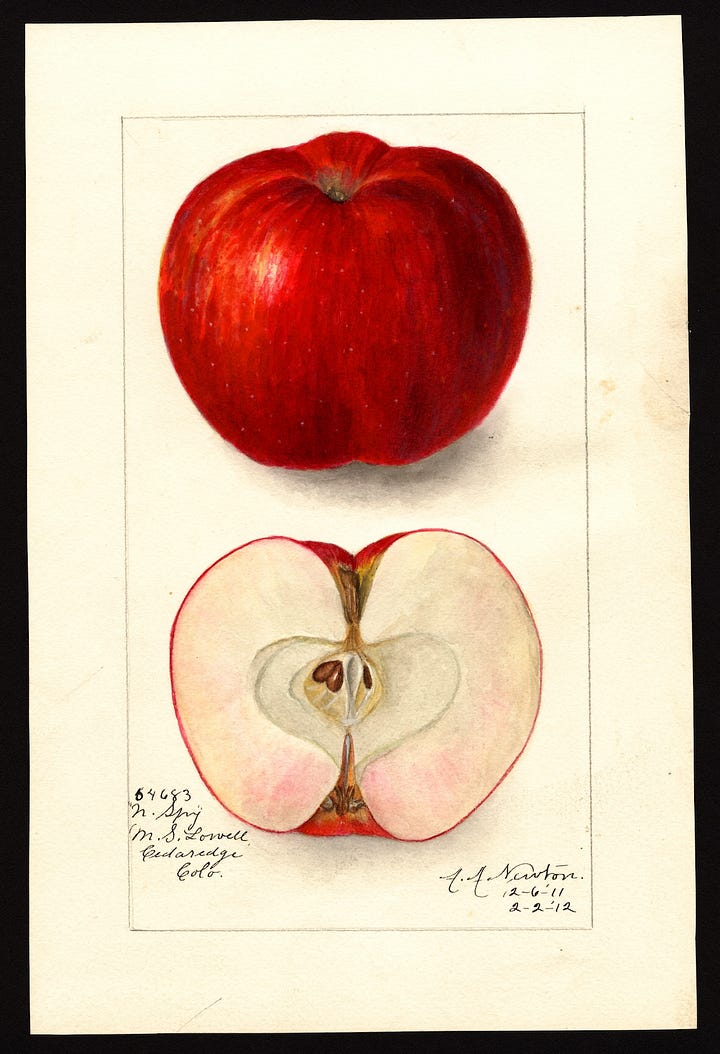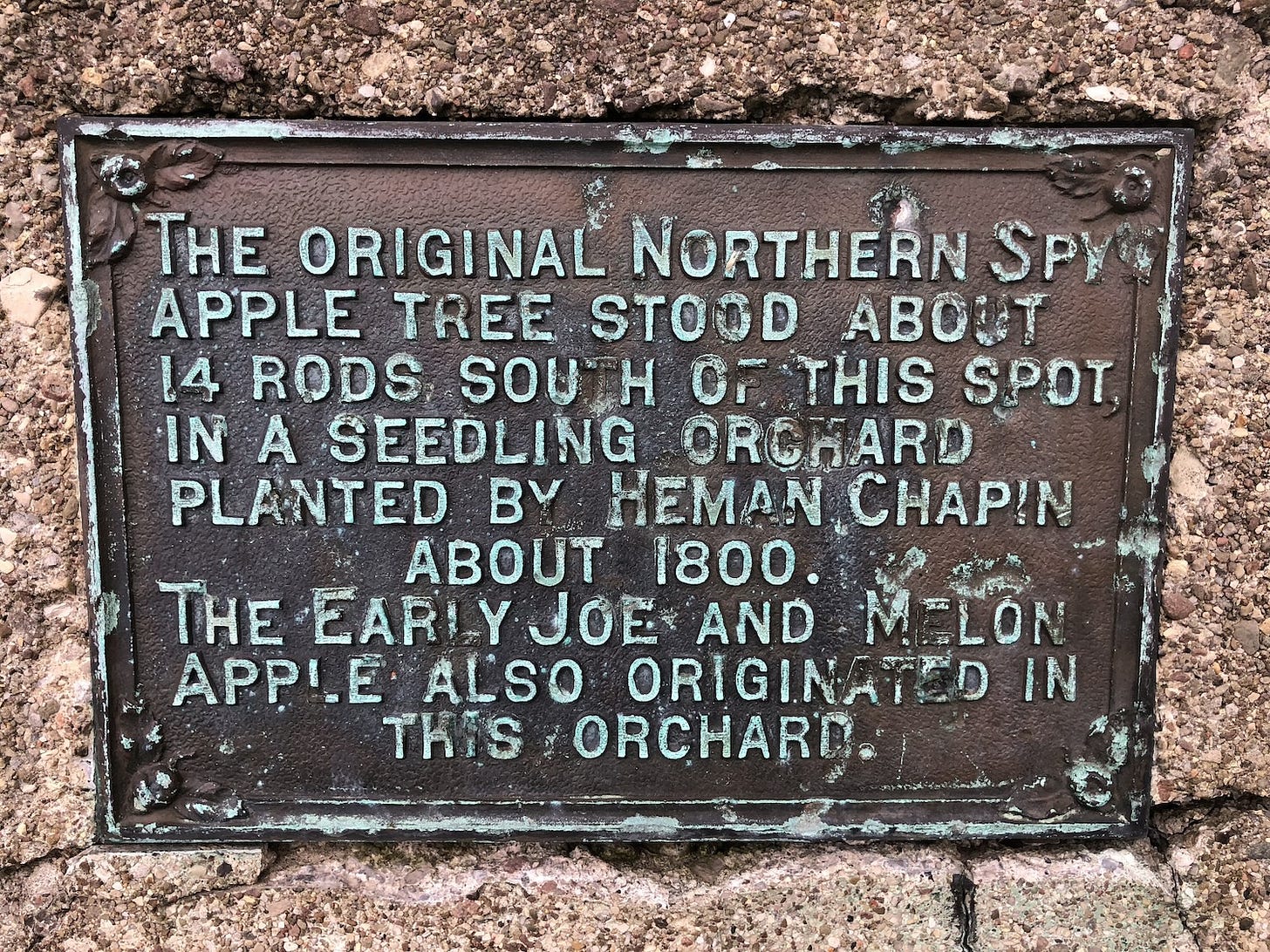The Northern Spy
How rabbits, a Quaker town, and a secret novel created an American apple


There's a bronze plaque in East Bloomfield, New York, marking where an apple tree once stood. Not the tree itself - that one was killed by rabbits before it could bear fruit - but its offspring, born from desperate shoots that emerged from the dying tree. The plaque doesn't mention the rabbits, whose descendants have never formally apologized. It doesn't mention the abolitionists either, or the spy novel, or the curious way this apple would weave itself into two centuries of American resistance movements. It simply states: The original Northern Spy apple tree stood about fourteen rods south of this spot.
The story begins in the 1630s, when the first wave of Puritans arrived in Massachusetts Bay Colony. Among them was Deacon Samuel Chapin, patriarch of a dynasty that would shape American history in ways both magnificent and strange. His descendants would include two presidents, T.S. Eliot, the author of Uncle Tom's Cabin, and the songwriter of Cat’s in the Cradle. If you aren’t familiar with that tune just know it’s the reason your dad sometimes gets emotional in the car.1
A century and a half later, one of those descendants, General Israel Chapin, was putting the finishing touches on a massive land deal with the Seneca Nation that would crack open western New York for American settlement. Word traveled fast through family channels. Brothers Heman and Oliver Chapin were among the first to buy tracts in this new frontier. Like good New England settlers, they cleared their land, built farmhouses, and planted apple trees.
Some of those trees came from seeds carried up from northwestern Connecticut by their friend Elijah Taylor. Among them was the antecedent of the Northern Spy, though its first incarnation met an inglorious end courtesy of the aforementioned rabbits. But Heman's brother-in-law Roswell Humphrey noticed water sprouts emerging from the tree's base and took cuttings to his nearby farm.
Meanwhile, the Northern Spy was in no hurry to reveal itself and the town of East Bloomfield sprang up around it. It had drawn a significant Quaker population in the years following General Chapin's land deals, and the Society of Friends forged the community's identity according to their own moral compass. By the time Humphrey's rescued trees finally bore fruit, East Bloomfield had established itself as a key stop on the Underground Railroad, its families quietly coordinating a network of safe houses for escaped slaves.
The true origin of the apple’s name remains buried in speculation. Some point to James Fenimore Cooper's 1821 novel The Spy: A Tale of the Neutral Ground, about Revolutionary War espionage. The connection isn't far-fetched — Cooper based the novel on John Jay, America's first spymaster and a colleague of General Chapin.
But in 1996, apple enthusiast Conrad Gemmer found a letter hidden in an obscure 1853 gardening magazine that hinted at a different provenance.2 Decades before the Civil War, an anonymous novel called The Northern Spy was circulating throughout abolitionist circles. Its hero posed as a slave catcher, traveling plantation to plantation across the South. While pretending to investigate potential escape methods for the plantation owners’ benefit, he was actually building an underground network, passing information about safe houses that stretched from Virginia through Maryland and Pennsylvania, all the way to New York and freedom in Canada.
The novel wasn't merely cheap fiction - it was a call to arms. Its pages detailed ambushes of slave catchers and advocated killing any Federal Marshal who captured a fugitive. The story culminated in a battle at Manassas, Virginia, where the spy is killed during The War to Free the Slaves - a prophecy that would come true on the same soil three decades later.3 Among Gemmer's evidence was a curious detail: his grandmother had owned a book of Civil War Anecdotes, where a Southern contributor blamed both The Northern Spy and Uncle Tom's Cabin for helping spark the conflict. The novel, they complained, had become a practical blueprint for resistance, emboldening abolitionists while terrorizing slave catchers.
Whatever the source of its name, the apple's reputation grew quickly. By the 1840s, Mount Hope Garden and Nurseries in Rochester had thousands of two-year-old trees ready for sale. Despite its tender skin, the Northern Spy proved remarkably resilient — bruises didn't lead to rot, making it an excellent keeper through winter. Its firm flesh and tart-sweet balance made it especially popular among bakers, who coined the saying Spies for pies! and insisted no other apple would do.
Today's commercial orchards have largely abandoned the Northern Spy. It takes ten years to start bearing fruit, often has a funky shape, and bruises and yields to disease too easily to cut it in the ruthless modern apple market. But it persists in heirloom collections and craft cideries, where it makes a complex and well rounded single varietal cider that beautifully expresses the character of its New York homeland.4
The apple made one final appearance in the annals of espionage in 1953, when the Toronto Globe and Mail sent a box to Senator Joseph McCarthy at the height of his communist witch hunt. McCarthy, who saw spies everywhere except his fruit bowl, apparently missed the joke.
The bronze plaque in East Bloomfield makes no mention of any of this, which is probably for the best. Some stories are better left uncast in metal, passed instead through whispered conversations and carefully packed boxes of fruit, and left shrouded in mystery. And if you ever get the chance to try one, thank a rabbit.
Harry Chapin:
To the Editor,
In reply to Mrs. B who inquired about the naming of the Northern Spy apple, everybody around here knows that the Northern Spy apple was named for the “hero” of that notorious dime store novel The Northern Spy, but nobody will come out and admit it.
Yours truly,
JBK
Rochester, N.Y.
The Battle of First Manassas (also called First Bull Run) in 1861 was the first true battle of the Civil War, and left 5000 dead.
Try the single varietal Northern Spy cider made by Eve’s Cidery in Van Etten, NY.





Another great read! The story of the Northern Spy is really interesting and so well written.
I loved this! Great job!